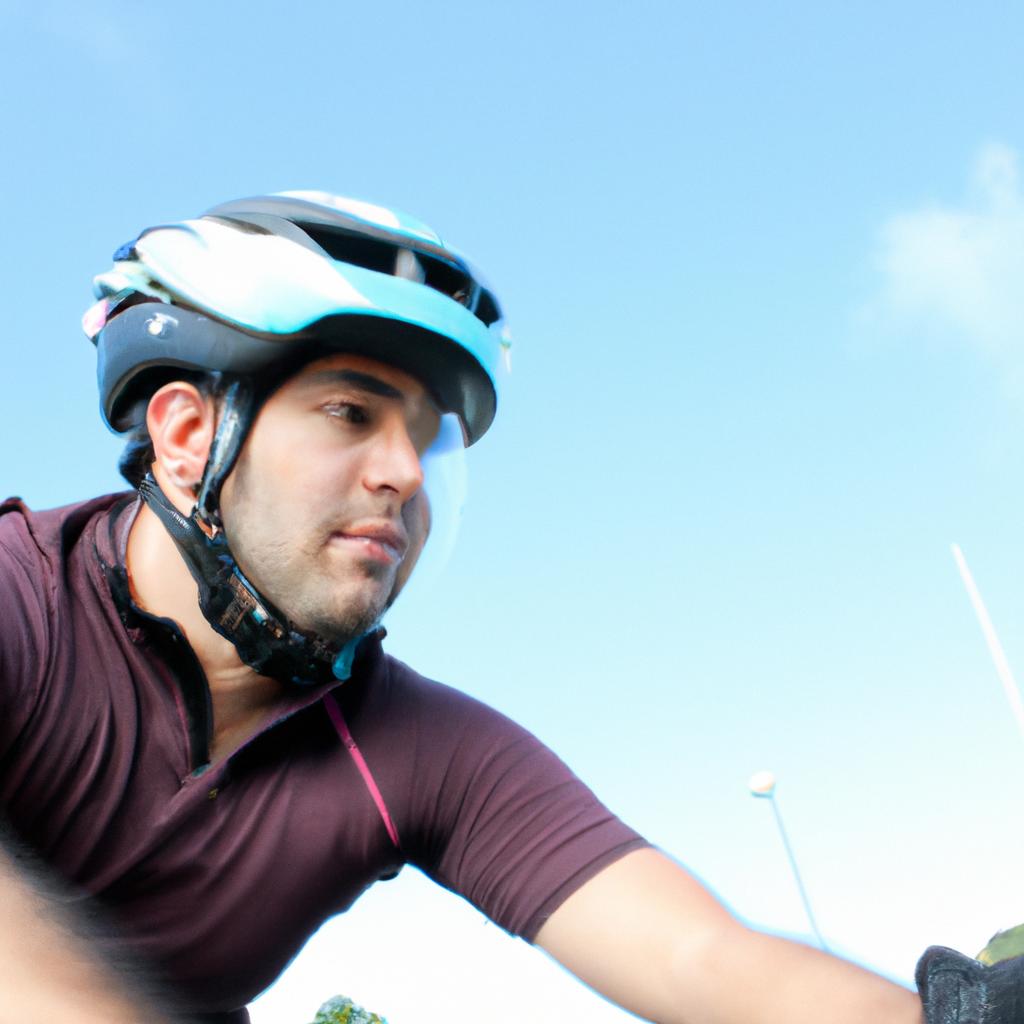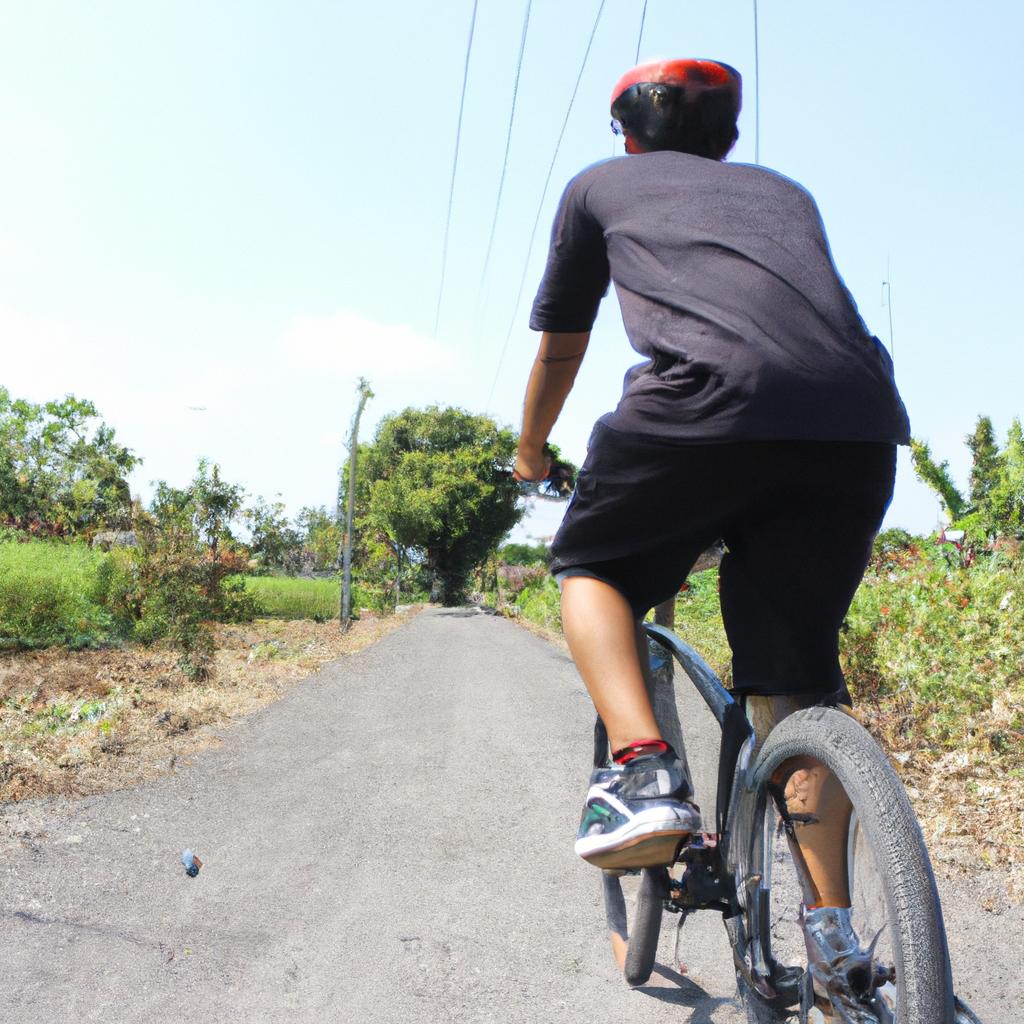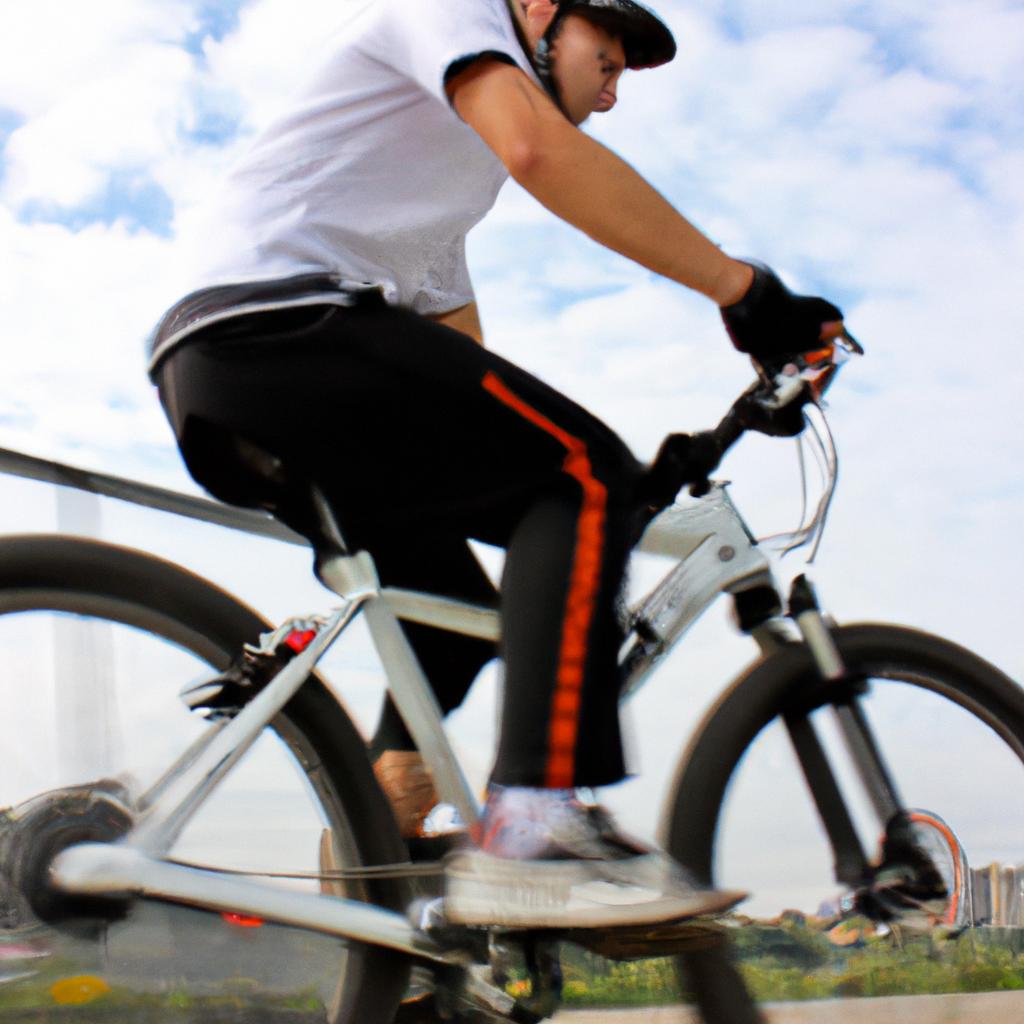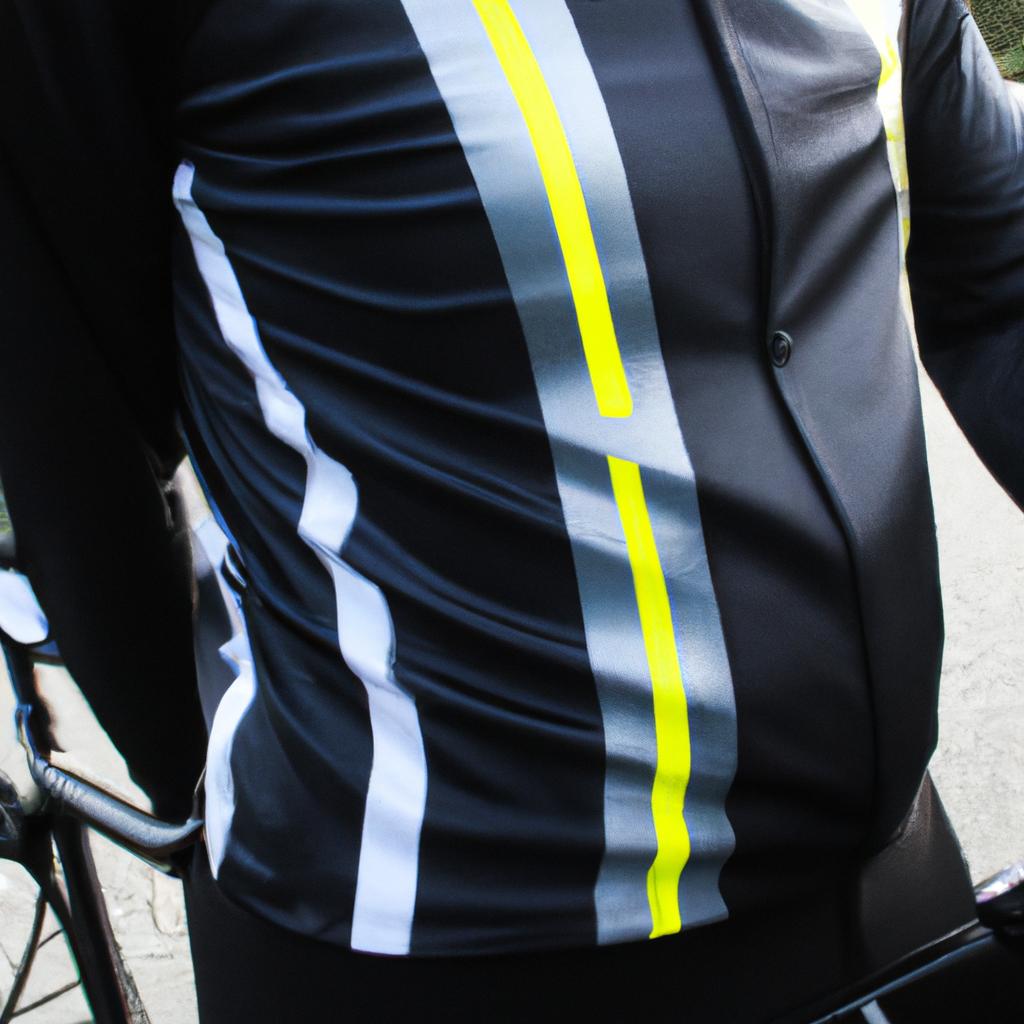Proper Bike Fit: Enhancing Bicycle Safety in Sports Cycling
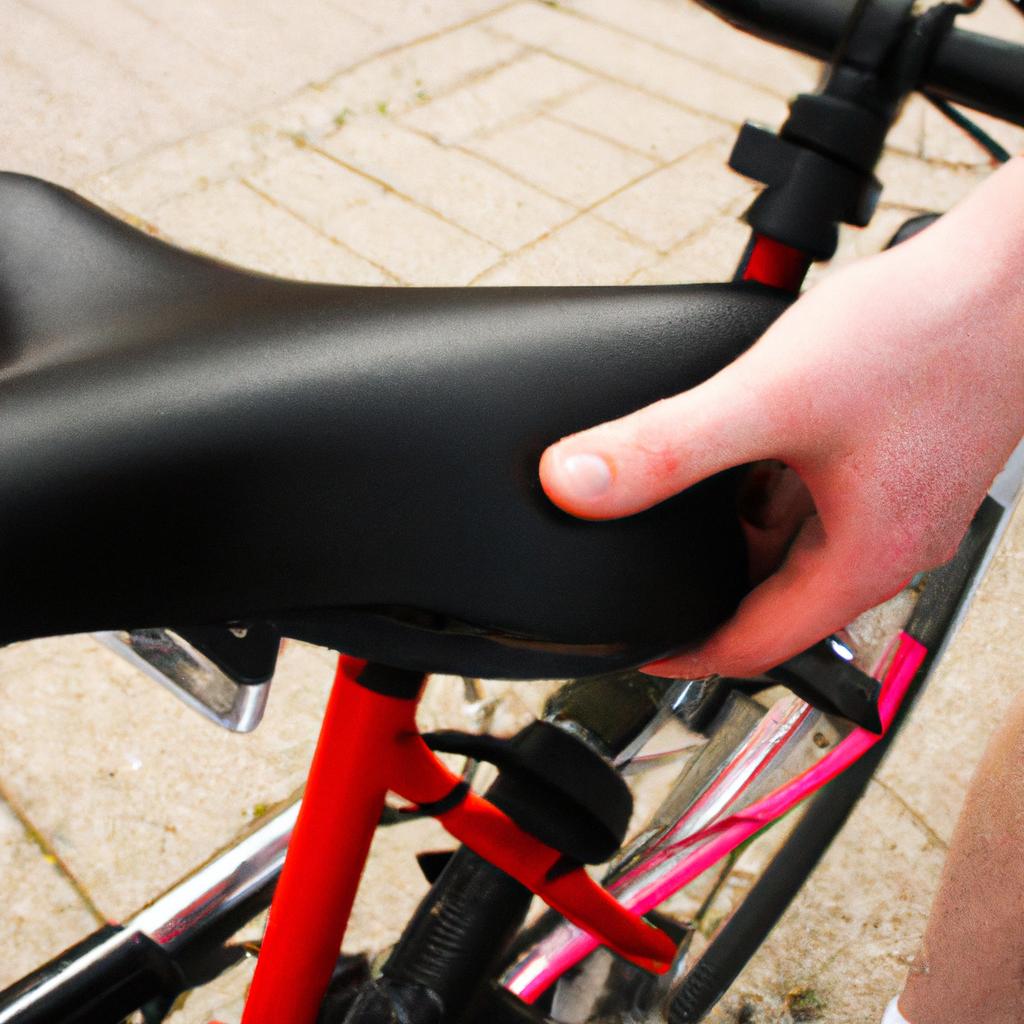
Bicycling is a popular sport and recreational activity enjoyed by individuals of all ages and fitness levels. However, it is crucial to ensure proper bike fit in order to enhance safety and prevent potential injuries. Consider the case of John, an avid cyclist who recently experienced discomfort and knee pain during his rides. Despite being physically fit, he found himself struggling to maintain balance and control over his bicycle. This example highlights the importance of understanding how proper bike fit can significantly impact one’s overall cycling experience.
Achieving optimal bike fit involves various factors that must be considered, including frame size, saddle height, handlebar reach, and pedal positioning. These aspects directly influence body alignment while riding and ultimately determine efficiency, comfort, and safety on the bicycle. Poorly adjusted bikes can result in musculoskeletal imbalances, leading to chronic pain or acute injuries such as strains or sprains. Moreover, inadequate bike fit may impair handling ability, affecting maneuverability and increasing the risk of accidents. Therefore, this article aims to explore the significance of proper bike fit for enhancing safety in sports cycling through examining its physiological benefits and addressing common misconceptions surrounding the topic.
Understanding the Importance of Proper Bike Fit
Imagine a scenario where an avid cyclist, let’s call him John, decides to participate in a challenging long-distance race. Despite having trained rigorously for months and possessing top-notch cycling gear, he finds himself struggling during the race. Fatigue sets in early on, his body starts to ache, and maintaining a steady pace becomes increasingly difficult. What could be causing this decline in performance? One important factor that is often overlooked is the significance of proper bike fit.
Achieving an optimal bike fit can greatly enhance both comfort and performance while reducing the risk of injuries associated with poor positioning. It involves adjusting various components of the bicycle such as saddle height, handlebar position, crank length, and pedal alignment to ensure that they are tailored to suit individual biomechanics. Neglecting these adjustments may lead to discomfort, inefficient energy transfer, decreased power output, and even musculoskeletal issues over time.
To emphasize the importance of proper bike fit further, consider the following bullet points:
- A correctly fitted bike allows for improved rider stability and control.
- Optimal weight distribution helps maintain balance and maneuverability.
- Proper alignment minimizes unnecessary strain on joints and muscles.
- Enhanced aerodynamics through correct posture reduces wind resistance.
In addition to understanding its benefits through bullet points, visual aids also prove helpful in grasping the significance of proper bike fit. Take a look at this table below that compares different aspects between two riders: one who has undergone professional bike fitting versus another who rides with an ill-fitted bicycle.
| Aspect | Rider A (Proper Bike Fit) | Rider B (Ill-Fitted Bicycle) |
|---|---|---|
| Comfort | High | Low |
| Efficiency | Maximum | Reduced |
| Injury Risk | Minimal | Increased |
| Performance | Optimized | Compromised |
As can be seen, the differences between a properly fitted bike and an ill-fitted one are quite significant. These variations directly impact a cyclist’s overall experience on the road or trail.
In conclusion, proper bike fit is not merely a luxury but an essential aspect of cycling that affects comfort, performance, and safety. Neglecting this crucial element may result in discomfort, reduced efficiency, increased risk of injuries, and subpar performance. Understanding the importance of achieving an optimal bike fit serves as a foundation for exploring the factors to consider in subsequent sections when aiming to enhance both physical well-being and cycling capability.
Factors to Consider for Achieving an Optimal Bike Fit
Having understood the significance of proper bike fit, it is crucial to delve into the various factors that contribute to achieving an optimal setup. By considering these factors, cyclists can ensure their safety and enhance their performance on the road or trails.
Factors to Consider for Achieving an Optimal Bike Fit:
-
Anthropometric Measurements:
- Body proportions play a fundamental role in determining the appropriate bike frame size and geometry.
- Example: Imagine a cyclist with shorter legs but longer torso. In this case, selecting a smaller frame size might result in discomfort and inefficient pedaling due to inadequate leg extension.
-
Flexibility and Range of Motion:
- The flexibility and range of motion vary among individuals, affecting how they interact with their bikes.
- Incorporating exercises and stretches specific to cycling can improve personal flexibility levels.
- Emotional Response Bullet Points (Markdown Format):
- Enhance comfort during long rides
- Reduce risk of muscular imbalances
- Increase power output potential
- Minimize strain on joints
-
Riding Style and Goals:
- Different cycling disciplines demand different riding positions and setups.
- For example, competitive road cyclists may prioritize aerodynamics by adopting a lower handlebar position compared to recreational riders seeking more comfort.
-
Injury History:
- Previous injuries or existing musculoskeletal conditions should be taken into account when optimizing bike fit.
- Consulting with medical professionals or specialists who understand both sports medicine and cycling mechanics can help determine modifications necessary for injury prevention/rehabilitation.
Table (Markdown Format):
| Factor | Importance |
|---|---|
| Proper saddle height | Ensures efficient transfer of power while minimizing knee stress |
| Handlebar reach | Promotes upper body stability and control |
| Cleat positioning | Optimizes foot alignment, reducing the risk of knee and ankle discomfort |
| Frame geometry and materials | Influences bike handling, comfort, and overall performance capabilities |
By addressing these factors when fitting a bicycle, cyclists can optimize their setup according to individual body characteristics and riding goals. The next section will explore the role of body measurements in achieving an ideal bike fit without relying solely on predetermined formulas or generic guidelines.
The Role of Body Measurements in Bike Fit
Having discussed the factors to consider for achieving an optimal bike fit, it is crucial to delve into the role that body measurements play in this process. By accurately measuring various aspects of a cyclist’s body, such as leg length and reach, cyclists can ensure their bikes are adjusted precisely to their individual needs.
To illustrate the significance of body measurements in bike fit, let us consider an example. Imagine a cyclist with shorter legs but longer torso compared to average proportions. If this cyclist were to ride a standard-sized bicycle without any adjustments, they would experience discomfort and compromised biomechanics during cycling. However, by considering their body measurements and making appropriate modifications – such as using a shorter stem or adjusting saddle height – they can achieve improved comfort and performance on the bike.
Body measurements serve as valuable indicators when determining how a cyclist interacts with their bicycle. Here are four key measurements that contribute to proper bike fit:
- Leg Length: Measuring from the heel to the crotch provides insights into saddle height adjustment.
- Torso Length: Understanding the length of the upper body helps determine frame size and handlebar position.
- Arm Reach: Determining how far a cyclist can comfortably reach forward aids in selecting appropriate stem length.
- Inseam Length: This measurement assists in establishing optimal crank arm length for efficient pedaling mechanics.
To further emphasize the importance of these body measurements, consider Table 1 below which showcases potential issues arising from improper fit and their corresponding emotional impact on cyclists:
| Issue | Emotional Impact |
|---|---|
| Knee pain | Frustration and disappointment |
| Lower back discomfort | Discomfort and discouragement |
| Numbness or tingling | Concern and anxiety |
| Neck strain | Fatigue and frustration |
Table 1: Emotional impact resulting from common bike fit issues.
In conclusion, body measurements play a vital role in achieving an optimal bike fit. By considering key measurements such as leg length, torso length, arm reach, and inseam length, cyclists can ensure their bicycles are adjusted to suit their unique anatomical characteristics. Doing so not only enhances comfort but also promotes safety and performance on the road or trail.
Understanding the role of body measurements is crucial for addressing common bike fit issues effectively. In the following section, we will explore these prevalent problems and provide practical solutions to help cyclists overcome them.
Common Bike Fit Issues and Their Solutions
In the previous section, we discussed the importance of considering body measurements when fitting a bike. Now, let’s delve deeper into this topic and explore how body measurements directly impact bike fit. To illustrate this further, let’s consider an example:
Imagine a cyclist named Sarah who recently purchased a new road bike. Despite her excitement to hit the road, she starts experiencing discomfort and pain after just a few rides. This prompts her to seek professional help for a proper bike fit.
When it comes to achieving optimal bike fit based on body measurements, there are several key factors to consider:
-
Frame Size: The size of the bicycle frame is crucial in ensuring proper alignment between the rider’s body and the bike components. A frame that is too large or too small can lead to poor posture and inefficient pedaling technique.
-
Handlebar Width: The width of the handlebars should correspond with the cyclist’s shoulder width. If they are too narrow or wide, it can result in discomfort and compromised steering control.
-
Saddle Height: Proper saddle height is essential for minimizing stress on the knees and maximizing power transfer during each pedal stroke. Incorrect saddle height can lead to knee pain, muscle imbalances, and reduced efficiency.
-
Crank Length: The length of the crank arms should be proportional to leg length. Choosing improper crank lengths can negatively affect biomechanics, potentially leading to overuse injuries such as tendonitis or patellofemoral pain syndrome.
To emphasize the significance of these considerations even further, here is a visual representation:

| Factor | Correct Fit | Incorrect Fit |
|---|---|---|
| Frame Size | Appropriate size allowing comfortable reach | Too small or large causing cramped or stretched position |
| Handlebar Width | Matches shoulder width providing optimal stability | Too narrow or wide causing shoulder discomfort and reduced control |
| Saddle Height | Properly aligned with the rider’s leg length for efficient pedaling | Too high or low leading to knee pain and decreased power output |
| Crank Length | Suitable length in relation to leg length, promoting optimal mechanics | Inappropriate crank length resulting in compromised biomechanics |
As we can see from this example and the various factors mentioned above, proper bike fit based on body measurements is crucial for enhancing comfort, performance, and most importantly, safety. By taking these measurements into account during the fitting process, cyclists can minimize the risk of injuries related to poor positioning and maximize their potential on the road.
Transitioning now to our next section, let’s explore how bike fit directly impacts injury prevention by examining its impact on overall cycling biomechanics.
The Impact of Bike Fit on Injury Prevention
Section H2: The Impact of Bike Fit on Injury Prevention
Transitioning from the previous section, where we discussed common bike fit issues and their solutions, it is crucial to understand how proper bike fit can play a significant role in injury prevention. To illustrate this point, let’s consider the hypothetical case of Sarah, an avid cyclist who experienced knee pain after long rides due to improper bike fit.
One key aspect of injury prevention through proper bike fit is ensuring optimal alignment and biomechanics while cycling. When a cyclist’s body is positioned correctly on the bike, there is reduced stress on joints and muscles, minimizing the risk of overuse injuries such as tendinitis or bursitis. In Sarah’s case, her knee pain was likely caused by excessive strain on her knees due to incorrect saddle height and fore-aft position.
To further emphasize the importance of bike fit for injury prevention, let us explore some key factors that contribute to enhancing safety while cycling:
- Proper saddle height: Adjusting the saddle height ensures efficient power transfer with less strain on the knees.
- Handlebar reach: Correct handlebar reach allows for comfortable upper body positioning and reduces unnecessary pressure on shoulders and wrists.
- Cleat placement: Optimizing cleat position improves pedaling efficiency and minimizes risks associated with foot pronation or supination.
- Frame size selection: Choosing an appropriate frame size based on individual measurements enhances stability, control, and maneuverability.
| Key Factors | Importance | Benefits |
|---|---|---|
| Saddle Height | Efficient power transfer | Reduced strain on knees |
| Handlebar Reach | Comfortable upper body positioning | Decreased pressure on shoulders and wrists |
| Cleat Placement | Improved pedaling efficiency | Minimized risks of foot pronation/supination |
| Frame Size | Enhanced stability, control, and maneuverability | Increased safety while cycling |
By prioritizing these factors and achieving a proper bike fit, cyclists like Sarah can significantly reduce the risk of injuries caused by improper positioning on their bikes. This demonstrates the importance of seeking professional bike fit services or implementing DIY solutions to ensure optimal alignment and biomechanics during cycling.
Transitioning into the subsequent section about “Professional Bike Fit Services and DIY Solutions,” it is essential to explore various options available for individuals who wish to improve their bike fit without expert assistance.
Professional Bike Fit Services and DIY Solutions
Having discussed the significant impact of bike fit on injury prevention, it is crucial to understand how professional bike fit services and do-it-yourself (DIY) solutions can contribute to enhancing bicycle safety in sports cycling. By exploring these avenues, cyclists can ensure their bikes are optimized for comfort, performance, and most importantly, reducing the risk of injuries.
Professional Bike Fit Services
One effective approach to achieving proper bike fit is through seeking assistance from professional bike fitters. These experts possess a deep understanding of biomechanics and ergonomics related to cycling. They utilize advanced tools and techniques to analyze individual riders’ body measurements, flexibility, joint angles, and riding styles. For instance, let us consider an example where a cyclist experiences knee pain during long rides due to improper saddle height. A professional bike fitter would assess the rider’s leg extension angle and make necessary adjustments to alleviate discomfort while enhancing power transfer.
Do-It-Yourself Solutions
While not as comprehensive as professional bike fit services, there are certain DIY methods that can aid cyclists in achieving better bike fit. These self-guided approaches involve adjusting various components such as saddle position, handlebar reach, and cleat alignment based on personal preferences and feedback from one’s own body. However, it is important to note that these methods may require some trial-and-error iterations before finding the optimal settings. Additionally, online resources like videos or step-by-step guides provide valuable insights into basic bike fitting principles that individuals can apply themselves.
The Emotional Impact of Proper Bike Fit
Properly fitting a bicycle not only enhances physical comfort but also evokes positive emotional responses among cyclists. Consider the following bullet points:
- Increased confidence in handling the bicycle.
- Sense of control over one’s ride.
- Reduced anxiety about potential accidents or injuries.
- Enjoyment and satisfaction derived from improved overall cycling experience.
Table: Emotional Responses to Proper Bike Fit
| Emotion | Description |
|---|---|
| Confidence | A feeling of self-assuredness and trust in one’s abilities. |
| Control | The ability to manage the bike effectively and effortlessly. |
| Security | Feeling safe and protected while cycling. |
| Satisfaction | Pleasure derived from a well-fitted bicycle setup. |
In conclusion, achieving proper bike fit is essential for enhancing bicycle safety in sports cycling. Professional bike fitters provide expert guidance based on individual body measurements and riding styles, ensuring optimal comfort and performance. Alternatively, cyclists can explore DIY solutions that allow for more personalized adjustments within their own preferences. By prioritizing proper bike fit, riders not only reduce the risk of injuries but also experience increased confidence, control, security, and overall satisfaction during their rides.

